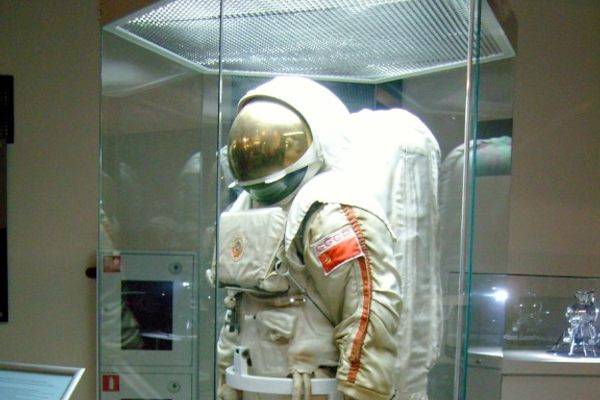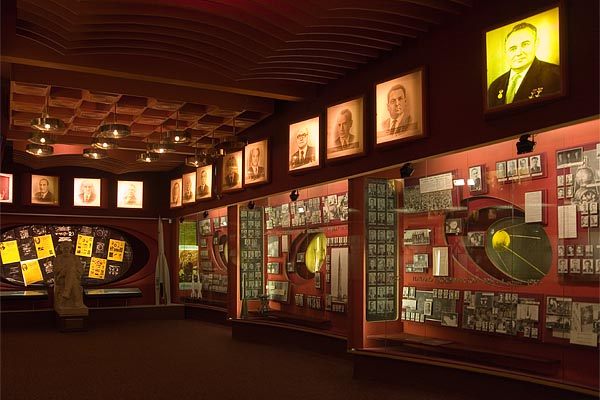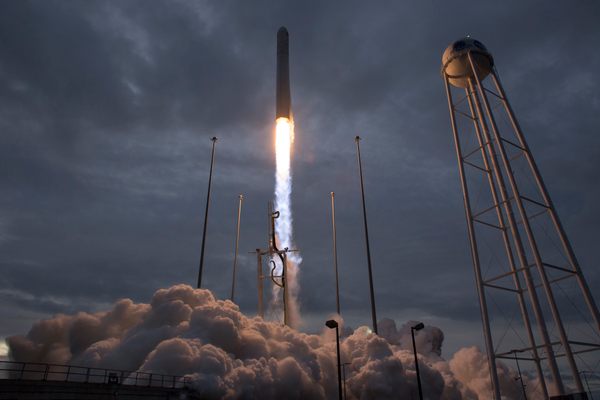Atlas Obscura’s Essential Guide to Cosmonautics
CCCP space poster of Yuri Gagarin
Human beings have been anatomically “human” for over 200,000 years. For 199,948 of those years we were grounded to the planet and its atmosphere, unintentional prisoners on “spaceship earth.”
52 years ago today a human being left our planet and entered the great void of space. He was no longer a member of planet earth, but the sole crew member of Vostok 1. His name was Yuri Gagarin and he was a cosmonaut.
Each year on April 12, the world celebrates this monumental day when the first person left our terrestrial realm and into the planets orbit. Yuri’s Night, also known as Cosmonautics Day and officially the International Day of Human Space Flight, celebrates not just his achievement, but the landmarks in space travel that came after. (Tragically, Gagarin did not see more space success as he died in a training jet crash in 1968, although oddly there’s this monument in Riga, Latvia that shows Gagarin as the old man he never became.)
At Atlas Obscura, we revel in the glories and successes of space travel. While NASA and the astronauts get a lot of attention here in the US, the Russian Cosmonauts are no less glorious, and were often forced to conduct their training in absolute secret.
In honor of Yuri, here is our Essential Guide to the Glory of Cosmonautics!
”Orbiting Earth in the spaceship, I saw how beautiful our planet is. People, let us preserve and increase this beauty, not destroy it!”
- Yuri Gagarin
STAR CITY
Zvyozdny Gorodok, Russia
Star City’s centrifuge whipped around cosmonauts at accelerations up to 8g. (via Bernt Rostad/Flickr)
Yuri Gagarin’s rocket ride into space history began in Star City.
The complex was once a super secret community for the cosmonauts and their families to live at during their training. Yet while in Gagarin’s day the place wasn’t even on the map, it’s now open to the public.
Visitors were first invited into Star City in the 1990s, and can now see training facilities like the tank where the cosmonauts learned to space walk, and the centrifuge that tested their endurance for nauseating speeds and force. There’s also a museum that holds a replica of Gagarin’s office along with vintage spacesuits and capsules.
Entrance to Star City (via Radio Nederland Wereldomroep/Flickr)
Inside Star City (via Radio Nederland Wereldomroep/Flickr)
The full-scale replica of MIR (via Brent Rostad/Flickr)
At Star City’s Hydro Lab, an entire mock spacecraft is submerged in a tank filled with water, the density of which helps to recreate the feeling of weightlessness for cosmonauts. (via PDXdj/Flickr)
BAIKONUR COSMODROME
Baikonr, Kazakhstan
Rollout of the Soyuz rocket for the Expedition 21 mission, September 28, 2009. (via NASA)
On April 12, 1961 at the Baikonur Cosmodrome, Yuri Gagarin uttered these final words before taking off on his landmark space journey:
“Dear friends, known and unknown to me, my dear compatriots and all people of the world! Within minutes from now, a mighty Soviet rocket will boost my ship into the vastness of outer space. What I want to tell you is this. My whole life is now before me as a single breathtaking moment. I feel I can muster up my strength for successfully carrying out what is expected of me.”
The facility built in the 1950s out in the desert of Kazakhstan is the largest and oldest space facility in the world. Although it was meant to be secret, its size couldn’t escape the American U-2 spy planes which caught sight of it in 1957 during the testing of the first intercontinental ballistic missiles. While Gagarin’s flight would of course be its crowning moment, its long history has included both success and tragedy, including the one-way mission of the first animal in space, the dog Laika.
Today visitors are invited to learn about the Soviet and Russian space programs in a museum, and some private tours even get to witness a space launch from the Cosmodrome.
Laika’s capsule at the Baikonur Space Museum (via Elisabetta Monaco/Flickr)
Rollout of the Soyuz TMA-18 for Expedition 23, March 31, 2010. (via NASA)
Rollout of the Soyuz rocket for the Expedition 21 mission, September 28, 2009. (via NASA)
Rollout of the Soyuz TMA-18 for Expedition 23, March 31, 2010. (via NASA)
Launch of the Soyuz TMA-16, September, 30, 2009. (via NASA)
MONUMENT TO THE CONQUERORS OF SPACE
Moscow, Russia
Monument to the Conquerors of Space (via Around the World in unknown Days/Flickr)
Before Yuri Gagarin ever made it into space, there was already a monument planned for the achievement. The Monument to the Conquerors of Space in Moscow, completed in 1964, commemorates the 1961 mission with a massive obelisk-like titanium statue topped by a soaring rocket.
Around it are stone reliefs showing scientists and cosmonauts hard at work on the Soviet space program, and in the adjoining Cosmonauts Alley are even more monuments to space heroes.
Top of the monument (via Wikimedia)
The Monument in 1967 (via Wikimedia)
Monument to Sergei Korolyov, the designer of space rocket systems, in Cosmonauts Alley by the Monument to the Conquerors of Space (via Wikimedia)
MEMORIAL MUSEUM OF COSMONAUTICS
Moscow, Russia
Yuri Gagarin’s space capsule (via Wikimedia)
Held in the base of the Monument to the Conquerors of Space is the Memorial Museum of Cosmonautics.
The museum opened on April 10, 1981 to mark 20 years since Yuri Gagarin’s achievement, and it chronicles the history of the Russian and Soviet space program with around 85,000 items on space technology, astronomy, and space travel.
These include Gagarin’s space capsule, along with space dogs, including Belka and Strelka, now taxidermied for posterity.
Belka the space dog (via Wikimedia)
Soviet cosmonaut statue (via Wikimedia)
SOVIET MOON SUIT
Moscow, Russia & Washington, DC
Soviet Moon Suit (via dctim1/Flickr)
One item of particular interest in the Memorial Museum of Cosmonautics is the Soviet moon suit.
There’s another just like it in the Smithsonian Air & Space Museum in DC. Naturally, they are in pretty good shape, because the Soviet space program never made it to the moon. The Krechet (“Golden Falcon”) weighs roughly 200 pounds and was entered through a door that opened on the back of the suit (the door doubled as a backpack for a life support unit).
The cosmonaut got out the same way with a trigger on the elbow of the suit. From the front folded out a control panel and a “hula hoop” around the suit let the cosmonaut roll over if he happened to get stuck on his back like some sort of cosmic turtle.
Soviet Moon Suit in the Smithsonian (Photo on left by the author, on right via Wikimedia)
Soviet moon suit (via Wikimedia)
RKK ENERGIYA MUSEUM
Korolev, Russia
Labour Glory Hall at the RKK Energiya Museum (via RKK Energiya)
Yuri Gagarin blasted into space in a rocket known as a Vostok 1, and when he came back to earth in the metal machine it returned to its birthplace: the RKK Energiya factory. Now the factory hosts a museum of the same name, the RKK Energiya Museum, celebrating Soviet and Russian space flight. Its collections include the legendary Vostok 1, as well as the Sputnik satellite.
Labour Glory Hall at the RKK Energiya Museum (via RKK Energiya)
Vostok 1 capsule (via Wikimedia)
Vostok 1 control panel (via Wikimedia)
NOVODEVICHY CEMETERY
Moscow, Russia
Grave of Pavel I. Belyayev (via Doug Alberg/Find a Grave)
While Yuri Gagarin is buried in the prestigious Kremlin Wall, the Novodevichy Cemetery is the final stop for many of Russia’s Cosmonauts.
Alongside the graves of Russian luminaries like Anton Chekov, Boris Yeltsin, and Mikhail Bulgakov are numerous cosmonauts and rocket engineers. These “eternal residents” include Gherman Titov, the second man in space, as well as Pavel Belyayev. Belyayev was the first person to command the Soviet cosmonaut corps, and he headed the 1965 mission where the first person walked in space.
His grave shows him life-size, stepping through a portal with his space helmet in hand, presumably going on to his next mission in some distant celestial sphere.
CELEBRATE COSMONAUTICS HISTORY:
STAR CITY, Zvyozdny Gorodok, Russia
BAIKONUR COSMODROME, Baikonr, Kazakhstan
MONUMENT TO THE CONQUERORS OF SPACE, Moscow, Russia
MEMORIAL MUSEUM OF COSMONAUTICS, Moscow, Russia
SOVIET MOON SUIT, Moscow, Russia & Washington, DC
RKK ENERGIYA MUSEUM, Korolev, Russia
NOVODEVICHY CEMETERY, Moscow, Russia










Follow us on Twitter to get the latest on the world's hidden wonders.
Like us on Facebook to get the latest on the world's hidden wonders.
Follow us on Twitter Like us on Facebook